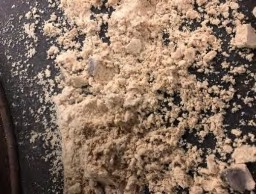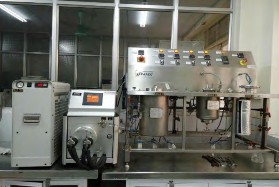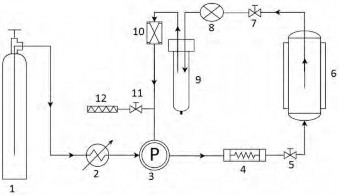UMSAEP-University of Pretoria Academic Exchange Program Report 2020-2021
New Global Markets for Invasive Species: Malnutrition, Hunger, & Health
Submitted by Dr. Mark Morgan
Associate Professor, School of Natural Resources University of Missouri-Columbia
and
South Africa Partner: Dr. Namrita Lall Professor, Medicinal Plant Science University of Pretoria
October, 2022
PROJECT OVERVIEW
Issue Identification
A feasibility study addressed solutions for malnutrition in South African women and children using a nutritional supplement made from silver carp (Hypopthalmichtrys molitrixi). This invasive fish is increasing in the U.S. after escaping captivity during the 1970s. Subsequent flooding resulted in unusually large concentrations in the Mississippi River and its tributaries, especially in the Illinois River. It is virtually impossible to eradicate an invasive species after it becomes established in a non-native environment.
Most Americans consider silver carp as a nuisance. Any reduction in the population will improve biodiversity of Midwest rivers, thus restoring native fish populations. Any intake of animal protein will be beneficial for rural women and young children in South Africa who often suffer from malnutrition. According to the Food & Agriculture Organization of the United Nations, nutritional deficiencies are related to each of the 17 Sustainable Development Goals. Although human consumption of inland fish is nothing new, using an invasive species to reduce malnutrition in developing countries is a novel solution for addressing two problems at once.
Wild-caught silver carp was processed and analyzed with help from domestic and international partners. The product was tested to determine if it could address nutritional deficiencies of women and children in South Africa, and perhaps other developing countries. Secondary aims of the project include identification of value-added, silver carp products such as those used for medicinal benefits or the cosmetic industry. Preliminary data analysis has shown some potential value of silver carp, thus giving hope to move this idea forward.
Intended Outcomes / Objectives
- Objective 1: Convert whole silver carp into powder
-
Objective 2: Create a liquid extract from silver carp powder using a supercritical CO2 machine
- Objective 3: Analyze the sample using modern metabolomics
-
Objective 4: Develop some value-added products made from AC that have potential applications for health and nutrition, medicine, and/or cosmetics in conjunction with formulators such as Letago pharmaceuticals, Pretoria, SA, & Botanica, Limpopo, SA.
Partners
Our interdisciplinary and multi-cultural team consists of individuals in fisheries, frozen foods, transportation & sales, food science, engineering, and metabolomics is well-positioned to analyze fish products and extracts. Members included: 1) Dr. Namrita Lall, professor of Medicinal Plant Science at the University of Pretoria (UP), South Africa; 2) Dr. Chung-ho Lin, associate professor of Agroforestry at the University of Missouri; and 3) Ms. Hoa Dinh, lecturer at Thai Nguyen University (Vietnam).
Methods
Silver carp was harvested from various portions of the Illinois River, downstream of Chicago, with help from fishers in the Midwest Fish Co-Op. After harvesting, fresh fish was transported to Sorce Freshwater in E. Peoria, IL for processing. This included grinding and putting them in cold storage. The slurry consisted of whole carp (head, bones, flesh, & intestines) which was turned into a powder (see Figure 1). This machine operates at a low temperature, thus
preserving all nutrients. It also makes use of the entire fish, so no waste product is created. The powder has a low water content and does not require refrigeration or freezing. It was kept in cold storage prior to the next step.

Figure 1. Asian carp powder.
Silver carp powder was sealed in vacuum-pack bags and sent to Vietnam for additional processing. A supercritical fluid extraction system (SFE) will be used at Thai Nguyen University to create a liquid extract from the powder. This is a viable approach to identify chemical compounds in silver carp, some of which might be valuable for human health and nutrition. This process also uses green technology, C02 gas and pressure to create a highly-purified fish extract that contains no heavy metal content (see Figure 2).


Figure 2. Schematic diagram of the supercritical CO2 extraction system: 1. CO2 cylinder, 2. Chiller, 3. CO2 pump, 4. Preheater, 6. Extraction vessel (1000 mL), 8. Back pressure regulator, 9. Separator, 10. Condenser, 12.
CO2 discharge line, 5, 7, 11. Valve
The literature suggests that silver carp is a good source of macro and micronutrients. Fish protein hydrolysates exhibit excellent functional properties (i.e., anti-oxidant, anti-microbial, anti-cancer etc.), making silver carp ideally-suited for several non-food applications, including health and medicine. However, the nutritional and mineral content will need to be verified using the powder and the liquid extract. The diet and mid-stream feeding behavior of AC decrease the risk of contaminants, especially for smaller fish (the ones used for this project). SFE removes heavy metal content in silver carp, thus ensuring safe consumption. Prior studies have only tested portions of silver carp, not the entire fish. Using the whole fish is a potentially viable and cost-effective strategy for managing invasive species to combat malnutrition.
|
Nutritional / Pharmacological Assays for testing samples of silver carp |
|||
|---|---|---|---|
|
Principle |
Method |
Other comments |
Previous activity according to literature |
|
Nutritional |
|||
|
Nutritional and mineral content analysis |
Analysis of dry matter and ash-, protein-, fat-, carbohydrate-and amino acid content |
Bighead carp is a rich source of omega-3 polyunsaturated fatty acids such as eicosapentaenoic acid (EPA) and docosahexaenoic acid (DHA). Silver carp also contains omega-3 fatty acids such as EPA and DHA. Previous studies have found the presence of omega 3 fatty acids in the oil. |
|
|
Antioxidant activity |
Free radical scavenging |
Free radicals available: Hydrogen peroxide Hydroxyl DPPH ABTS Superoxide Nitric oxide |
Antioxidant analysis on hydroxyl radical scavenging was done on carp that was combined with alcalase and flavourzyme) |
|
Nutraceutical |
|||
|
Anti-cancer |
Cytotoxicity testing on cell lines |
Cell lines available: Human cervical cancer cell line (HeLa) Human epidermoid carcinoma cell line (squamous cell carcinoma) (A431) Human malignant melanoma cell line (pigmented melanoma) (UCT-Mel-1) Mouse melanocytes (melanoma) (B16F10) Human liver cell line (hepatocellular carcinoma) (HepG2) Human breast adenocarcinoma (MCF-7) Lung carcinoma (A549) Human prostate cancer |
Fish oil has previously been tested against cancer, which is present in both species, as previously mentioned. The omega 3 fatty acids found in the oil potentially reduce colorectal, prostate and breast cancer. One study saw that these fatty acids such as DHA (Docosahexaenoic acid) can potentially inhibit the growth of some cancers in mice. This includes breast, lung, prostate and colon cancer. It was also observed in this study that DHA will induce dose-dependent apoptosis in cancer cells, as DHA modifies the |
|
(DU 145). Subjected to activity observed, the AC-samples may be considered for an adjuvant, nutritional supplement for cancer and/or for a cosmetic product, should there will be activity against skin-cancer cell line. Selected samples may be further tested in a study to evaluate its potential for sun-protection factor. This may result into formulating a cosmetic product, having Sun protection which may be used for preventing skin-cancer. |
expression of proteins of the Bcl-2 family. This is by means of increasing the levels of the pro-apoptotic proteins such as Bak and Bcl-Xl. It was also seen that it induces the release of cytochrome-c from the mitochondria which will also lead to apoptosis occurring. |
||
|
Oral care |
Antibacterial activity against common oral pathogens |
Bacteria: Prevotella intermedia ATTCC 25611 Streptococcus mutans ATTCC 25175 |
The scales and bones of both Bighead and Silver carp are a source of gelatin. The gelatin found in the byproducts of fish has shown to possess antibacterial properties. Inhibits Escherichia coli, Staphylococcus aureus, Bacillus subtilis, Salmonella enteritidis and Shigabacillus. |
|
Evaluation of AC-samples for their potential for Cosmeceuticals |
|||
|
Anti-acne |
Anti-bacterial |
Bacteria: Propioni-bacterium acnes ATTCC 6919 |
The gelatin of the fish, which fish? has shown to possess antibacterial properties. Inhibits Escherichia coli, Staphylococcus aureus, Bacillus subtilis, Salmonella enteritidis and Shigabacillus. |
|
Anti-wrinkle |
Elastase inhibition |
Enzyme: Porcine pancreatic elastase |
|
|
Collagenase inhibition |
Enzyme: Collagenase |
Have found that these samples contain large amounts of collagen within their scales, bones, skin and fins. Within the skin 75% of the dry weight contains collagen. |
|
RESULTS & DISCUSSION
Nutritional analysis
A nutritional analysis was conducted on the powdered whole and non-edible silver carp. The results obtained were compared to articles that analyzed similar parameters, however, the extraction methods were different. Most of the articles on silver carp were more concerned about contaminants such as mercury, rather than its nutritional value. Overall, three articles were found that contained some nutritional content on silver carp. Below is the comparison between the data obtained versus the results obtained by the other three articles.
Table 1. This article used the white muscle of the ventral, dorsal and tail of farmed and wild silver and Grass carp. These were compared to the results obtained from ARC.
|
Analyses |
Whole vs non-edible vs wild vs farmed silver carp |
|||
|---|---|---|---|---|
|
ARC obtained results |
Article based results |
|||
|
Whole carp |
Non-edible carp |
Wild silver carp |
Farmed silver carp |
|
|
Moisture (%) |
7.14 |
10.07 |
78.79 |
77.89 |
|
Protein (%) |
51.57 |
38.62 |
15.50 |
16.11 |
|
Arginine (g/100g) |
4.53 |
2.98 |
1.60 |
1.60 |
|
Aspartic acid (g/100g) |
3.03 |
3.99 |
6.95 |
7.01 |
|
Glutamic acid (g/100g) |
5.39 |
5.75 |
4.01 |
4.83 |
|
Threonine (g/100g) |
6.22 |
1.81 |
1.45 |
1.53 |
|
Alanine (g/100g) |
6.10 |
2.33 |
5.98 |
6.17 |
|
Tyrosine (g/100g) |
4.25 |
0.83 |
2.43 |
2.45 |
|
Proline (g/100g) |
0.92 |
1.67 |
2.25 |
2.29 |
|
Methionine (g/100g) |
1.04 |
0.93 |
2.30 |
2.48 |
|
Valine (g/100g) |
2.48 |
1.98 |
1.49 |
1.59 |
|
Phenylalanine (g/100g) |
1.85 |
1.51 |
6.30 |
7.02 |
|
Isoleucine (g/100g) |
2.13 |
1.80 |
6.0 |
6.5 |
|
Histidine (g/100g) |
1.02 |
1.11 |
1.32 |
1.34 |
|
Lysine (g/100g) |
3.91 |
3.34 |
1.90 |
1.92 |
Table 2. This article used farmed silver carp that had its scales, head and viscera removed as well as deboned before being made into mince. These results are compared to the data obtained from ARC.
Analyses
|
Whole silver carp vs non-edible silver carp vs fresh minced silver carp |
|||
|---|---|---|---|
|
ARC obtained results |
Article based results |
||
|
Whole carp |
Non-edible carp |
Fresh minced carp |
|
|
Moisture (%) |
7.14 |
10.07 |
80.97 |
|
Ash (%) |
21.09 |
16.61 |
1.21 |
|
Protein (%) |
51.57 |
38.62 |
16.68 |
Table 3. This article used farmed silver carp at a live weight of 3.50 kg that was descaled, gutted and filleted. These fillets were divided into two parts (dorsal and ventral), which were further divided into three segments (cranial, medial and caudal). These results were compared to the data obtained from ARC.
|
Analyses |
ARC obtained results |
Article based results |
||||||
|---|---|---|---|---|---|---|---|---|
|
Whole carp (%) |
Non-edible (%) |
Dorsal |
Ventral |
|||||
|
Cranial (g/kg) |
Medial (g/kg) |
Caudal (g/kg) |
Cranial (g/kg) |
Medial (g/kg) |
Caudal (g/kg) |
|||
|
Dry matter |
92.86 |
89.93 |
269.89 k/kg |
281.96 |
272.73 |
350.16 |
393.83 |
322.40 |
|
Ash |
21.09 |
16.61 |
11.00 |
10.79 |
10.66 |
8.87 |
8.33 |
10.10 |
|
Protein |
51.57 |
38.62 |
172.53 |
171.57 |
167.26 |
146.41 |
141.16 |
154.30 |
|
Fat |
15.41 |
30.88 |
32.33 |
48.14 |
57.69 |
164.11 |
195.64 |
114.68 |
Elastase
None of the extracts displayed anti-elastase properties at the highest testing concentration (4 mg/mL) while the positive control (ursolic acid) showed an IC50 of 5.00 ± 2.84 µg/mL. As of current, the biological activity of silver carp has not been conducted.
Tyrosinase
During this study, the by-product of the silver carp when extracted using CO2 displayed the lowest IC50 value as demonstrated in Table 4 with the positive control showing a value of 5.70
± 1.79 µg/mL. As of yet, the anti-tyrosinase activity of silver carp has not been examined.
Table 4. Anti-tyrosinase activity of prepared silver carp extracts
|
Sample |
IC50 a ± SD (mg/mL) |
|---|---|
|
Whole extract |
3.28 ± 0.78 |
|
Non-edible extract |
3.14 ± 0.25 |
|
CO2 extracted oil |
3.04 ± 0.74 |
|
CO2 extraction by-product |
2.37 ± 0.67 |
A: Value at which the extracts inhibit 50% of the activity
DPPH activity
Of the four extracts that were prepared from silver carp, only the CO2 extraction by-product displayed antioxidant properties with an IC50 of 122.3 ± 0.85 µg/mL while the positive control (vitamin C) showed a value of 50.57 ± 0.89 µg/mL.
Antiproliferative activity
Antiproliferative activity against MCF-7 and HaCaT was conducted to determine whether these extracts are harmful towards normal and breast cancer cells. The IC50 values obtained were
displayed in Table 5. Extracts that display a significant antiproliferative activity against cancer cell lines display an IC50 below 50 µg/mL with moderate ranging between 50-200 µg/mL, low between 200-1000 µg/mL and no activity above 1000 µg/mL. Of the silver carp extracts, whole silver carp extract displayed low antiproliferative activity against both cell lines while the by-product obtained after CO2 extraction only showed antiproliferative activity against MCF-7.
Table 5. Antiproliferative activity of silver carp extracts against breast cancer (MCF-7) and human keratinocyte (HaCaT) cells at a testing concentration of 4 mg/mL.
|
Samples |
Breast cancer (MCF-7) |
Human keratinocyte (HaCaT) |
|---|---|---|
|
IC50 a ± SD (mg/mL) |
||
|
Whole silver carp |
786.20 ± 0.92 µg/mL |
962.83 ± 0.92 µg/mL |
|
Non-edible |
3.28 ± 0.70 |
NA b |
|
CO2 extracted silver carp oil |
1.35 ± 0.86 |
1.20 ± 0.94 |
|
By-product after CO2 extraction |
801.57 ± 0.96 µg/mL |
2.50 ± 0.89 |
|
20% DMSO |
9.08 ± 0.89% |
5.10 ± 0.92% |
A: Value at which 50% of the cells have undergone cell death, B: IC50 value above the highest testing concentration (4 mg/mL)
Table 6. Metabolomic analysis of the liquid extract
|
Compound |
Health Benefit |
|---|---|
|
Isofucosterol |
anti-cholesterol, anti-cancer |
|
Stigmasterol |
anti-inflammatory |
|
Fucosterol |
anti-cancer, antidiabetic, antioxidant |
|
Stearoylethanolamide |
regulation of inflammation and pain |
|
Theobromine |
useful in asthma and in other respiratory tract problems |
|
Paraxanthine |
central nervous stimulant and exerts anti-inflammatory effects |
|
Nervonic acid |
repair the damaged brain nerve pathways and promote the regeneration of nerve cells |
|
Fusidic acid |
used to treat bacterial infections |
|
γ-Linolenic Acid |
anti-inflammatory |
|
Arachidonic Acid |
fundamental role in the proper function of the brain and muscles |
|
Eicosapentaenoic Acid |
blood pressure control, alleviating symptoms of rheumatoid arthritis and depression, attenuating the progression of Alzheimer’s disease |
|
Alpinumisoflavone |
antioxidant and anti-inflammatory, antimicrobial, anticancer |
Conclusion
The SFE extraction process was ideal for the silver carp powder. Of the four extracts that were prepared using silver carp, only the by-product obtained after CO2 extraction displayed anti-tyrosinase and antioxidant properties with an IC50 of 2.37 ± 0.67 mg/mL and 122.3 ± 0.85 µg/mL while exhibiting low antiproliferative activity towards breast cancer while showing no effect on HaCaT cells. This is very useful information. The metabolomic results using the liquid extract were also very promising, as were some of the nutritional tests. Other data is available on the edible portions of silver carp for comparison purposes. Relative concentrations of the chemical compounds need to be determined before product development can occur.
Reviewed 2025-11-20